
|
||
|
Portland art blog + news + exhibition reviews + galleries + contemporary northwest art
|
||
China at Reed China Urban is a tour. So, this review seems appropriately written in the form of my critical travelogue consisting of the opening night and a subsequently less crowded visit:
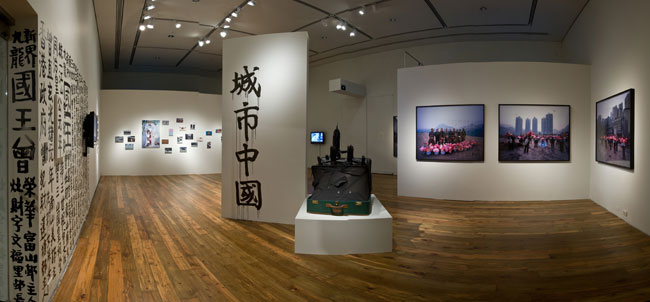 Cooley Gallery Entrance On opening night at the Cooley, standing at the entrance and already China Urban's aesthetic is effectively achieving a tight, busy configuration echoing the hustle and bustle of urban Chinese life. Initially I respond to the show with surprise, primarily due to the flood of people crowding in the gallery space, obstructing my view as person after person peels off of me. A well-dressed middle-aged Asian man painting Chinese calligraphy on the walls catches my attention. Then suddenly a small opening in the midst of the sea of people allows for a view of artwork - lots of artwork. For a moment, everything is happening at once. BOOM! A diagonal wall with graffiti (in Chinese characters) divides the typical rectangular shape, tightening the space and steering the flow through the gallery, reflecting the line of sight to three of Chen Qiulin's 48 by 60 inch photographs.  Gallery Shot: Parabolic Speakers Looking up, I see parabolic speakers hanging from the ceiling like space ships. Suddenly, there are now more video displays and even more people in several directions at once. The dislocating scene causes a sudden thought: "Am I in the Cooley Gallery?" Remembering the flyer in the library and a blurb on the web, I recall that Dr. Yang Jiyu is doing a performance based on The King of Kowloon, which consists of writing calligraphy on the gallery walls. Why The King engaged in the ancient tradition of Chinese calligraphy is less certain, but Dr. Jiyu seems very fixed on two things: reading the piece of paper he is holding, and writing what is on it. 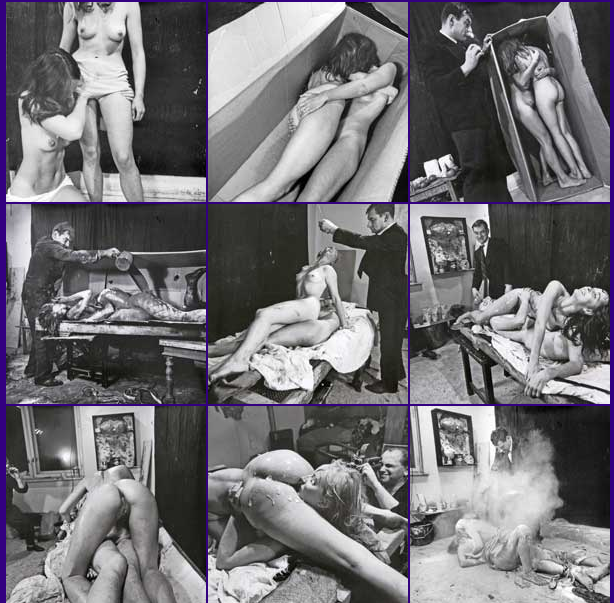 Otto Muehl - ACTIONISM Material Action Nr. 14 Cosinus Alpha So, I press on, reflecting on the performance occurring behind me with the comforting knowledge that a man writing graffiti on a wall in a foreign language is not nearly as strange as most anything Otto Muehl has done or Vito Acconci's Seedbed. Reading the brief, student-written description of the work, it informs me that Tsang Tsou-Choi (The King of Kowloon) struggled with his writing through out his life. It was only at the end of his life he gained recognition for his cultural contributions and gained fame and "commercial success" - where he worked with people to reproduce his stylistic writings on clothing and other graphic design. After reading this I realize the performance is much like the clothing that utilizes the "King's" writings. The reproductions and the performance lose the controversial, schizophrenic and idealistic edge of The King. Out of Hong Kong, the writing's transgressive context is gone. Paradoxically enough, I find my slight claustrophobic panic is quelled somewhat by this lack of context. Further into the gallery I walk. At this point the show guides me by an odd aura of vagueness, co-sponsored by feelings of claustrophobia and lethargy. 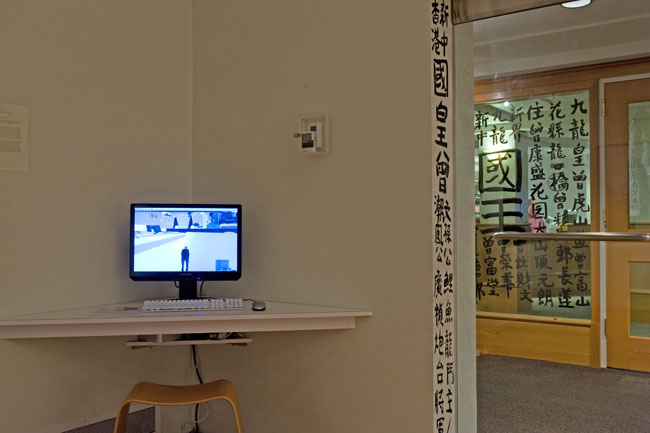 Gallery: Cao Fei, RMB City Next I find myself torpidly glancing at a computer where people are cued up in line to play the video game Second Life, I walk by without stopping. The idea of waiting in line, other than for entry, is very unappealing. I move on with ease knowing that Cao Fei's RMB City piece will be open later.  Cao Fei RMB City Moving onward, I overhear some college kids say "I didn't know China was so bleak," and while looking around suddenly I'm surrounded by six desolate photographs of torn down buildings with backgrounds of slowly adjusting smog gradients that fade into a deep hazy pollution. Together, these images are pretty intimidating. Putting the viewer suddenly at visual gunpoint and without a word I agree with the students in a privately serious candor, as if I am six years old again at a funeral, not sure what to feel or why people are sad, but positive the occasion is a serious one. 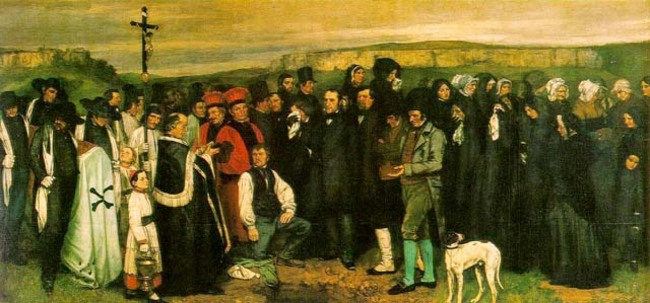 Gustave Courbet, Burial at Ornans Between the six photographs, there are two different projects: The four by Chen Qiulin are focused on groups of people with large vases and flowers. The two photographs by Xie Xiaoze and Chen Zhong focus on walls of ruined buildings covered by paper before they became part of the forcibly abandoned and submersed city by the Three Gorges Dam completion. Government validation of this massive wreckage and exodus is expressed in the Maoism, "We must have faith in the masses and we must have faith in the Party. These are two cardinal principals. If we doubt these two cardinal principles, we shall accomplish nothing." Meditating on these photographs and the symbols they use elucidates some of the consequences such accomplishments like the Three Gorges Dam project have incurred, adding a layer of depth that news broadcasts in the USA at the time were lacking. Yes, there is a deeper narrative behind the photographs, but overall they are lacking an aesthetic technical quality that leaves me wanting more. Chen Qiulin, Xiaoze and Zhong might have had more effective photographs if they used a compare and contrast approach like the Michael Marten show at Blue Sky. 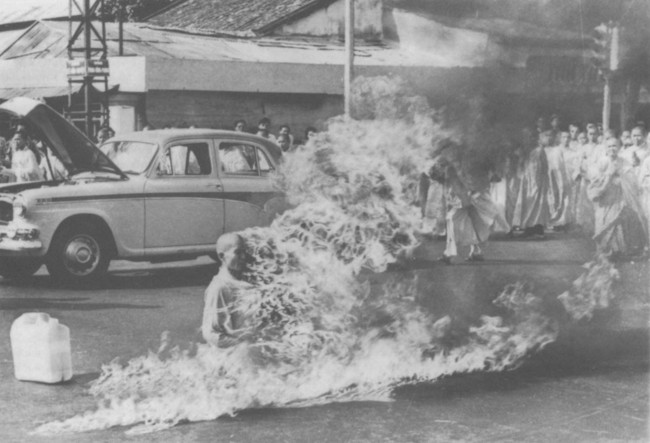 Photographer: Malcolm Browne Feeling a slightly stronger panic induced by the photographic holdup, I noticed the simultaneity of three different videos accompanying the six chromogenic prints. I then navigated a left around the diagonal wall to the end of the hall and into a micro theater, complete with a black and white film projected on the walls and beanbag chairs scattered throughout the space. The isolated open, dark room with only one thing happening is quite a pleasant surprise for such a busy show. Within China Urban this is the place viewers could meditate. Snagging a beanbag, I absorbed the movie entitled Seven Intellectuals in a Bamboo Forest, pt.2. My first thought was, "What happened in part one that I am missing?" This Yang Fudong film is centered around seven characters discussing existential topics that one might talk about with one's own friends, with the added, as student Lindsey Putnam states, "vapid sexual relations" that are found in Hollywood movies and soap operas. Fudong's visual and conversational elements are jazz-like, using spicy notes in counterpoint to large ponderous spaces, like hearing Blue Monk in half tempo. The film is a perpetual nostalgic event mixing contemporary and ancient Chinese philosophies. It is like watching a series of still photos or trapped moments where people are talking about sex, culture, work and whatever else in life that seems like it should be easily solved during a conversation with close friends, though the end of the conversation usually ends without anything being decided. The point he aims to make is noble; Fudong wants to bridge the histories of China and relate the struggles of centuries past -- both internal/spiritual and external/cultural -- to those of contemporary Chinese people. But after twenty inconsequential minutes of lethargic existentialism I found it less engaging than Chasing Amy. Of course one could decide to give the claustrophobia outside the micro theater another chance. 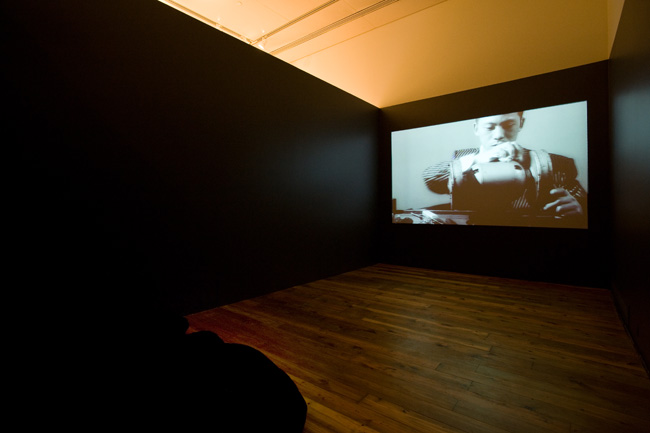 Gallery: Yang Fudong, Seven Intellectuals in a Bamboo Forest, pt.2. Returning to the main part of the gallery, I realized that the show is not as crowded or populated as I originally thought, although the work still has many opposing ideas happening at once - despite its obvious Chinese thread. Yes, all the work is centered on the idea of urban Chinese life, overpopulation, pollution and cultural devastation, but each piece is having a different conversation that would be better managed as a one-on-one. But that is a luxury China doesn't have and China Urban chooses not to afford in such a limited space with so many pieces to sample. 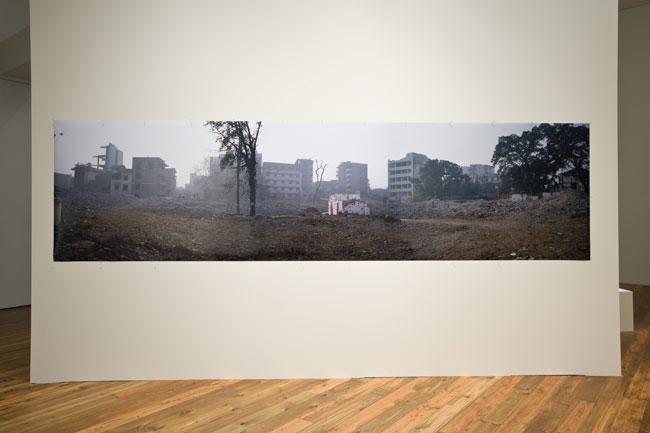 Gallery: Xie Xiaoze and Chen Zhong, Last Days On the back side of the diagonal wall is an impressively large third documentation photograph from Xie Xiaoze and Chen Zhong's Last Days project. Walking back to the entrance and knowing that the image is pre-Three Gorges Dam communicates that the space in the picture is now totally submerged under the Three Gorges Dam reservoir. Having the same aesthetic battle as with the six photographs earlier, I feel sad about what the photograph represents but not much about the photograph itself other than its titanic size. After the momentary emotion fades, I still feel disconnected. I make my way back through the gallery to snap a couple videos for my web blog and then make my way out. Coming back a week later with the space completely void of people, the experience was the diametric opposite of the opening. The gallery is now host to a ghost town ambiance, much like Xie Xiaoze and Chen Zhong's photos. The mock King of Kowloon has finished his writing performance - still, all the writings are able to communicate visually is graffiti in Chinese, which to us is exotic but hardly transgressive, causing it to be lost in translation. Then I sat down to my first encounter with Second Life, an interactive online community in which Cao Fei has created an avatar named China Tracy. She, within Second Life, has created an entire city of her own named RMB City. 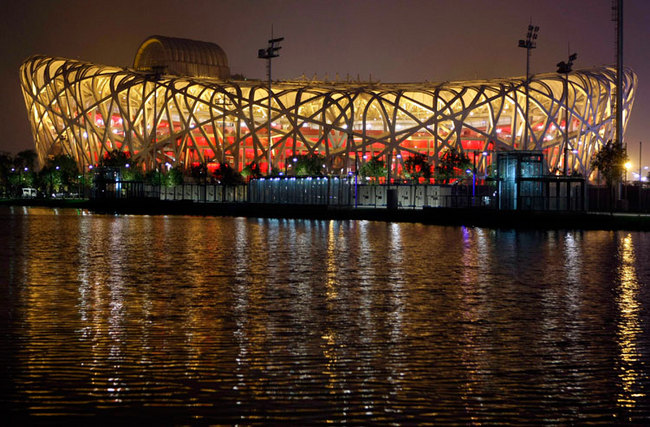 Herzog and de Meuron, Beijing Olympic stadium Fei's semiotics utilize images the media has made familiar to a global audience, like the new Herzog and de Meuron Beijing Olympic stadium, large industrial smoke stacks and the Rem Koolhaas CCTV building. The visual vernacular of computer graphics uses recognizable landmarks that didn't exist fifty years ago in a language that matches. Cao Fei's up-to-date international conversation is the reason this piece made it into the Venice Biennale. In a very inventive way, RMB City simultaneously comments on the follies, hardships and turmoil within the culture, transcending China via the internet and proving Cao Fei to be a contributing member of the international avant-garde. Because RMB City is holistically the best piece in the show, it is necessary to note that there are laminated instructions beside the computer monitor to assist the first-time users. There are several tips, but an important one is lacking: "Use the scroll button to zoom into first person mode so you can fly up and down." After you get that, game play is mostly good for the basic visual arts purpose of seeing life as China Tracy. Without even thinking about it, I was on the computer for half an hour looking at a show within a show. Mastering the flying-up-and-down strategy, I was able to see many satirical images creating a commentary about contemporary China in a relevant and engaging dialect. As a bonus, players realize a gallery bound video game is equally engrossing as playing one in an arcade or at home.  Cory Archangel, Super Mario Clouds Providence then gifts you with someone to relate your overwhelming philistine feelings to: After finishing your Second Life session, a student from the class that has helped curate the show walks into the gallery and, during a conversation I am standing in on, questions the value of RMB City as art. Her seemingly brash questioning eventually makes sense beyond her cutaneous argument when she expresses not fully understanding how to play the video game. That one frustrating tip without which you don't know how to play isolates many viewers. For me this student's struggle to utilize the game controls is an ironic metaphor for my take on China Urban's ineffectively busy aesthetic and overwhelmingly informational prerequisites. So does the show work? The Cooley gallery's mission is "to enhance the academic offerings of Reed College with a diverse range of scholarly exhibitions, lectures, and colloquia in its role as a teaching gallery," and in the respect of educating students and faculty connected to the show, it is a success. But for outside viewers without the direct guidance and laborious historical research from Confucianism and Maoism to now, there are many spots in the show that seem incomplete. It is as if something is missing, metaphorically speaking. And it is not that the show is bad; actually, the show is one of my favorite shows for Spring 2009. But a significant part of China Urban is curated by students and geared towards students. Thus the need for a class on understanding the art of contemporary China is what is hindering some viewers from a deeper integration into this show. But even the best short narrative -- much like a show review -- cannot achieve the complete objective contextual justice of taking a class or going to a show. 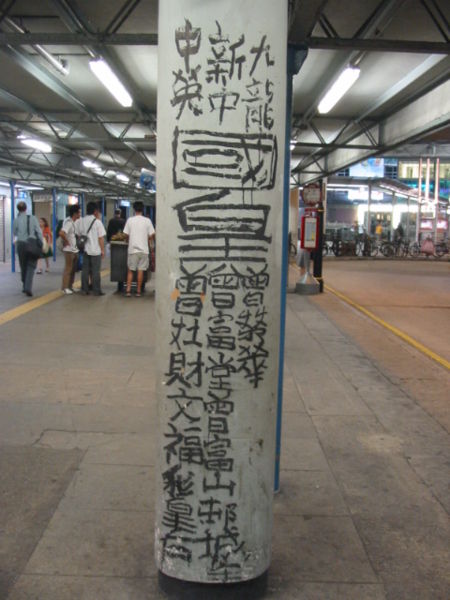 Tsang Tsou-Choi Back to the show, accompanying the wall caligraphy/graffiti left over from the King of Kowloon performance, there is also a short documentary that is very informative. And without the active presence of someone writing on the wall, the video takes charge as the graffiti becomes wall paper. The video shows the real King: Tsang Tsou-Choi in his original context, crutching around Hong Kong writing messages on any surface he pleases about his family, displacement, heritage, British imperialism and life. I am unsure if his fame is derived from his writings about his cultural displacement from his native land or his schizophrenic obsession with writing in public spaces about the land and family he loves, loses and eventually regains after his commercial success. It is a story made for a Hollywood movie. Regardless, within the documentary, his obsession for writing creates a tearing paradox in his life that forces his family to abandon him. Yet, he continues to live out his idealism despite outside doubt and persecution from his society and family. He is the ideal case of the Van Gogh syndrome. The world is a place where personal idealism, sacrifice and suffering to the point of martyrdom is a pinnacle in fine art that few have achieved. When an artist becomes a martyr (living or dead), coupled with the right people noticing his or her work, the notion of the punished artist enters a transcended/vogue state. 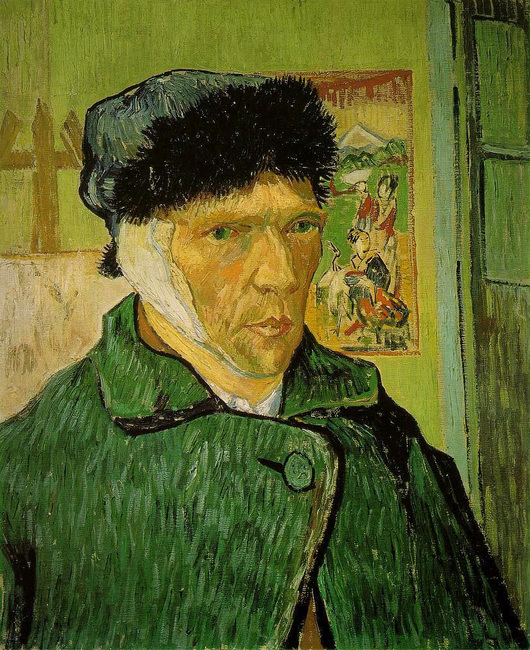
Van Gogh, Self-Portrait with Bandaged Ear 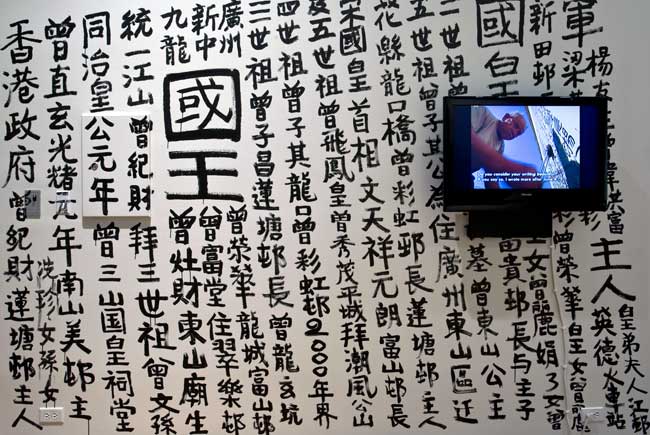 Gallery: Tsang Tsou-Choi Installation and Video Tsang references the ancient tradition of Chinese calligraphy and shoves it into a quasi-communistic society - overpopulated, with every wall or surface owned by an entity. To place it into context: You write on notepads -- or nowadays more likely a digital program -- but Tsang, like the ancient monks wrote on walls, worked out his poetry wherever he was compelled. Conversely, the reenactment of King of Kowloon is absent the schizophrenic-martyr who writes on whatever he pleases without rules; the new writing in China Urban is ineffective and controlled. The writing doesn't serve as anything more than a life-sized example of what The King once wrote to express his dissatisfaction with his world. In fact, Dr. Yang Jiyu's reading of the King's writings seems counterintuitive - the idea The King stood for is becoming part of the system. The inevitable consumption by the system does not belittle his achievements of standing alone for what he believed in until his death. His beautiful distrust, continual investigative introspection and crystallized idealism is something that everyone can learn from, even if it is something that you or I cannot or would not do ourselves. 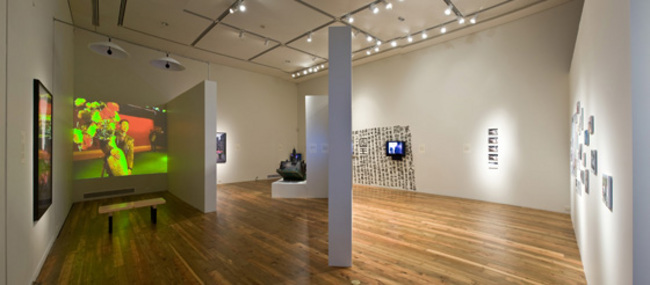 Cooley Gallery Far Side of the Gallery This show is NOT a quick read, and without a bare minimum one hour, one will not have any representation of what is in China Urban. Even with an hour one feels unintentionally crowded, disconnected and out of context relating to the work. This is the conflation of contemporary displacement between reemerging cultural histories as Maoist China transforms into a Communist-Capitalist government. Regarding The King of Kowloon and RMB City: Two all-stars can take a team far in the playoffs, but it does not mean that they are going to take home the championship. One cannot help but feel like a philistine, at times overwhelmed by the space and lacking the authoritative information that allows for the inner Roland Barthes to be muted. Lost in translation, the death of the author has diminished China Urban of its powerful commentary. The show and the accompanying catalogue are seemingly star-crossed lovers that are ironically set to publish on the day the show closes (June 7th). It seems fitting to leave with a quote from PORT's Okwui Enwezor's interview: Collectively put together, one thing next to the other, you begin to piece together this complex mosaic of thoughts, of experiments, of proposals, of inventions, of innovation that all, cumulatively not only enlarge our understanding of the value of art, but also have the capacity for cultural, political, social, and dare I say, spiritual renewal. Posted by Alex Rauch on May 15, 2009 at 10:20 | Comments (1) Comments In the Sheltering Sky Paul Bowles explored the very dislocated experience of being a tourist and in many ways China Urban has to have a similar effect on the viewer... because it is often a tour of Urban Chinese ennui. Bowles also made a distinction between tourist and traveler in that a traveler gets integrated amongst the land and people they are visiting.... for a tourist there is a buffer... in this case it's art and that is part of the existential experience that looking at art almost always has. Obviously that is a bit impossible for an art show, unless we could do studio visits. Still, one wishes that Chinese art was a little stronger than it is (Cao Fei, Huong Yong Ping and a few others excepted) Posted by: Double J Post a comment Thanks for signing in, . Now you can comment. (sign out)
(If you haven't left a comment here before, you may need to be approved by
the site owner before your comment will appear. Until then, it won't appear
on the entry. Thanks for waiting.)
|
| s p o n s o r s |
 |
 |
 |
 |
 |
 |
 |
 |
 |
 |
 |
 |
 |
 |
 |
 |

|
Site Design: Jennifer Armbrust | • | Site Development: Philippe Blanc & Katherine Bovee | |


![[TypeKey Profile Page]](http://www.portlandart.net/nav-commenters.gif)